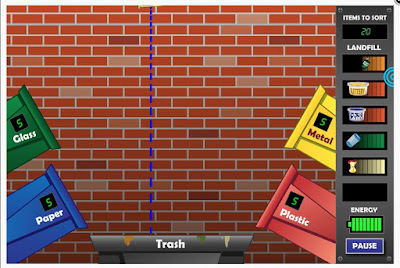 One of those games is called Power Up, and I would say that it is more reaction and reflex-based than most of the other ones, but it is quite addictive, and I could easily see younger kids getting hooked to it. In the game, the player controls a solar panel on the ground that can move left and right, as well as a wind turbine that can move up and down. Players use the arrow keys, to control these movements. Clouds appear to create patches of shadow that players have to avoid in order to collect the most amount of sunlight. Simultaneously, regions of wind will pass from left to right or vice versa, and players must move the turbine up and down accordingly to generate the most wind energy. A time limit helps determine if you get a bronze star, and silver star or a gold star. I loved how simple the controls and concept was. One of the problems with the game, in my opinion, is that it is not challenging enough to keep me engaged for long periods of time. There are simple mobile games that have become addictive addictive simply because of their challenging objectives or the monotony of how long they go on. Even on the hardest difficulty, I can complete the game with a gold star without hardly any practice.
One of those games is called Power Up, and I would say that it is more reaction and reflex-based than most of the other ones, but it is quite addictive, and I could easily see younger kids getting hooked to it. In the game, the player controls a solar panel on the ground that can move left and right, as well as a wind turbine that can move up and down. Players use the arrow keys, to control these movements. Clouds appear to create patches of shadow that players have to avoid in order to collect the most amount of sunlight. Simultaneously, regions of wind will pass from left to right or vice versa, and players must move the turbine up and down accordingly to generate the most wind energy. A time limit helps determine if you get a bronze star, and silver star or a gold star. I loved how simple the controls and concept was. One of the problems with the game, in my opinion, is that it is not challenging enough to keep me engaged for long periods of time. There are simple mobile games that have become addictive addictive simply because of their challenging objectives or the monotony of how long they go on. Even on the hardest difficulty, I can complete the game with a gold star without hardly any practice.The other game that I tried out was called Recycle This, which, as you probably guessed, has players operating recycle and trash bins. Random bits of trash will fall, and the player has four possible to which the food can be tossed to: paper, glass, plastic, and metal. What is great about this game is that it subconsciously teaches the players about which trash belongs in which bin. Now I suppose you could say that this is common knowledge, but not everyone pays attention to what gets thrown into its proper disposal. All of the games that I found have relatively simple objectives associated with them. They are a resource for teachers in middle schools, certainly. Here is the full games list.

Do you think kids would play these games on their own, or would they be best suited for playing in the classroom?
ReplyDelete